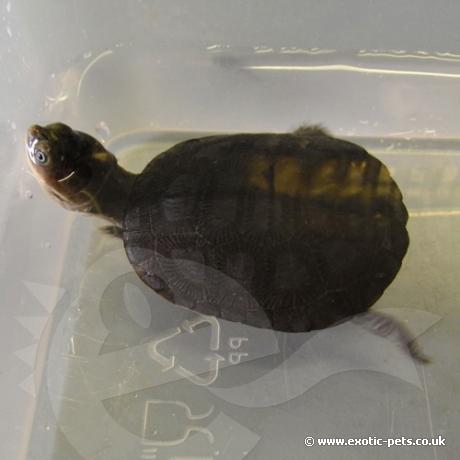

African Helmeted Turtle are relatively small turtles. They are found throughout Africa, from Ghana all the way to the Cape of Africa.
| Origin | Africa |
|---|---|
| Environment | Semi-Aquatic |
| Adult Size | 20cm |
| Suitability | Intermediate |
| Lifespan | Up to 50 years |
| Temperament | Aggressive towards other species |
The African Helmeted Turtle is a relatively small species that reaches around 20cm (8 inches). They have a smooth black to brown shell, the top of limbs are greyish in colour whereas the underside is more yellowish.
One characteristic we like about this species is their face. They have a small pig-like nose and a large smiling mouth, giving them the appearance of always being happy.
Unlike other species of the Pelomedusa family, African Helmeted Turtles do not have a hinged plastron (lower shell) that can be pulled shut to protect the front legs and head. However, due to their thick muscular neck, if this turtle falls onto it’s back, it can quickly right itself by using the neck as an extra limb. They will also tuck the neck in as far as they can and sideways if they feel threatened.
Males can be identified by their large thick tail, females generally have a short tail and a broader carapace.
The African Helmeted Turtle inhabits a large portion of Africa, from the Cape Peninsula to the Sudan. It’s also found as far west as Ghana and as far south as Cape Town. They prefer standing water like swamps, marshes, rain pools and lakes, however, they do live next to flowing rivers. They can be aggressive towards other species of turtles or even to smaller helmeted turtles, therefore it is very important not to mix this species.
This is a semi-aquatic turtle and should be provided with both a land and water area, therefore a large tank is required. Babies and juveniles can be kept in an aquarium with floating land or built up land areas, adults are best kept in large turtle tubs.
With any turtle species, a good filter is required; external filters are probably the best giving your turtles more space to swim. Internal filters can be bulky and may require more frequent cleaning. The African Helmeted Turtle does not like fast flowing currents, therefore place this on a low flow setting. Regular water changes should be carried out weekly with one-third of the water being replaced. When using water from the tap, a de-chlorinator should always be used and never put ice cold water in, otherwise you will give your turtles thermal shock.
With turtles, it is important to provide the correct air temperature along with water temperature. There are a number of ways to provide basking sites. We prefer mercury bulbs in large open enclosures as this provided both UVB and heat. Bulbs can be used in smaller aquaria tanks, we recommend only using turtle bulbs as these are normally splash proof, therefore not blowing, unlike other standard reptile bulbs. A basking site of 32-35C (90-95F) and a water temperature of 26-28C (80-83F) should be maintained.
As mentioned above, mercury bulbs provide the turtles with UVB to help with bone, shell and growth development. If using an aquarium, a UVB strip light of 10-12% should be used. A few interesting facts about these turtles; if there is a drought, the turtle will burrow down into the substrate and wait for rains to come. They can be in this state anywhere from a few months up to a year. They will also hibernate during very cold weather, and aestivate during unusually hot, dry weather.
Feeding is easy as African Helmeted Turtles are omnivorous, eating many food items. In the wild, they feed on insects, fish, tadpoles, snails, earthworms, vegetation and carrion. They use their sharp claws to rip food up while eating in the water. In captivity, a selection of turtle foods is available from pellets to natural dried insects. Frozen foods are available with insects and added vegetation; these are better for younger turtles. Earthworms, snails and other live food items can be given, ensure crickets and mealworms are fully gut loaded as dusting the food can be tricky when feeding in the water.